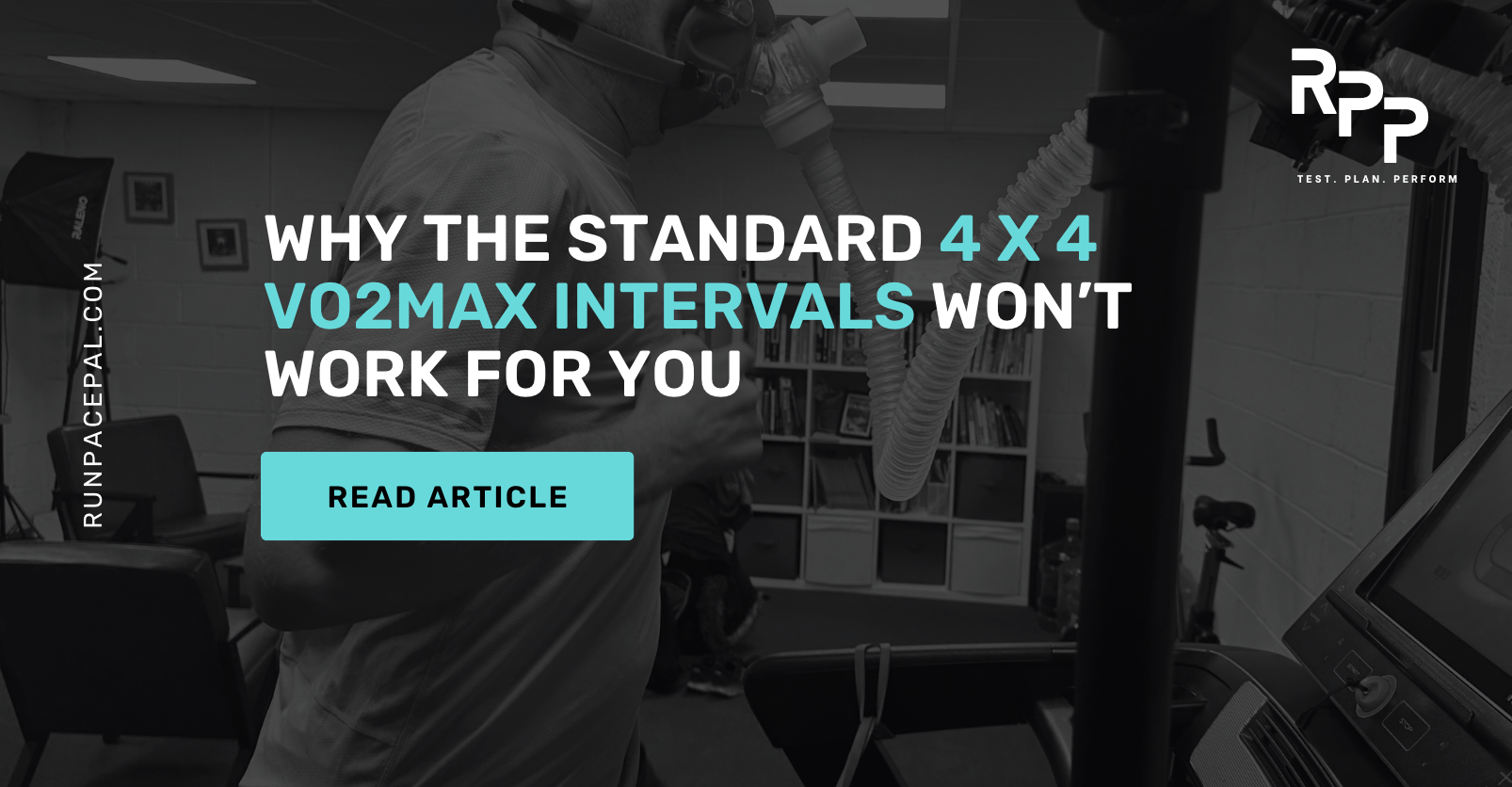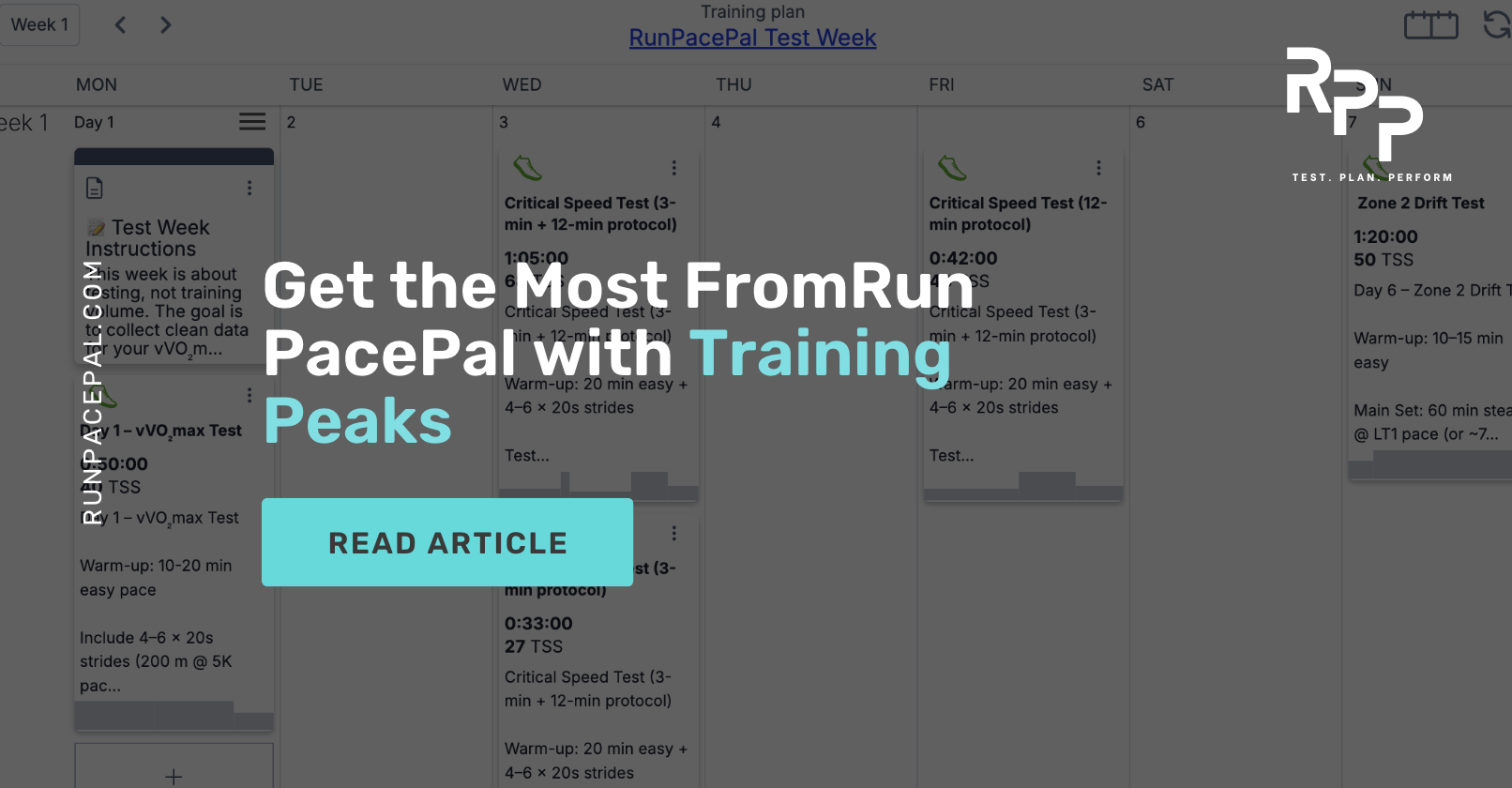Why the Standard 4 × 4 VO₂max Intervals Won't Work for You
If you Google "VO₂max workout," you'll find endless versions of the same prescription: 4 × 4 minutes hard, 2–3 minutes easy.
It's simple. It's famous. And for some athletes, it works.
But here's the truth: for most runners, the 4 × 4 is a blunt tool — sometimes too easy, sometimes too hard, and rarely the most efficient way to train.
Where the 4 × 4 Came From
The "4 × 4" model became popular through research in the early 2000s, particularly from Norwegian sports scientists (Wisløff, Helgerud, Hoff). They tested runners and found that 4 × 4-minute intervals at 90–95% HRmax improved VO₂max and endurance in recreational athletes.
The formula caught on. It was simple to prescribe, looked neat in a training plan, and didn't require complex testing.
But there's a problem: training isn't one-size-fits-all.
The Problem With 4 × 4
1. HRmax Is an Inaccurate Target
The 4 × 4 relies on percentages of max heart rate.
- As we've seen, HRmax formulas are often ±10–20 bpm off (Tanaka et al., 2001)
- This means your "90–95%" might actually be way above or below the intended intensity
- One runner's 95% HRmax could be another's threshold pace
2. VO₂ Kinetics Differ Between Athletes
- Some athletes reach VO₂max quickly (fast kinetics)
- Others take longer to achieve peak oxygen uptake
- For the latter, 4 minutes might not even be long enough to hit the target
- Fast-kinetics athletes might plateau after 2 minutes, wasting the remaining time
3. Critical Speed and D′ Matter More
The 4 × 4 ignores Critical Speed (CS) and D′ (anaerobic reserve).
- For some, 4 minutes at 90–95% HRmax is below CS — too easy for VO₂max stimulus
- For others, it's well above CS — burning through D′ too quickly and causing premature fatigue
- This leads to inconsistent training stress and adaptation
Research Evidence: Dupont et al. (2002) showed that shorter intermittent bouts (e.g., 30/30s) often produce more time at VO₂max than continuous 4-minute reps (PubMed 12179954).
4. It Ignores the Goal of the Session
- Do you want to improve VO₂max? Threshold? Running economy?
- The 4 × 4 doesn't distinguish. It just throws everyone into the same bucket
- Different physiological systems require different training stimuli
What the Science Really Says
VO₂max Training
Requires repeated time at or above 90% VO₂max. How you get there depends on your VO₂ kinetics and individual response.
Threshold Training
Best targeted with cruise intervals or continuous tempos, not 4-minute max efforts that overshoot the target.
Efficiency Training
Comes from Zone 2/3 steady work, not from high-intensity 4 × 4s that stress different energy systems.
In other words: the 4 × 4 is a hammer. But not every training problem is a nail.
Better Alternatives
Billat 30/30s
Protocol: 30 sec at ~vVO₂max, 30 sec jog recovery
Benefits: - Allows much more time near VO₂max without full burnout - Proven to improve VO₂max and running economy (Billat et al., 1996) - Matches individual VO₂ kinetics better than long intervals
Cruise Intervals
Protocol: 5–6 × 6 min at LT2, 1 min recovery
Benefits: - Build threshold power and lactate clearance - Target specific physiological adaptations - Sustainable intensity for consistent quality
Over/Unders
Protocol: 2–3 min just above LT2, 2–3 min just below LT2
Benefits: - Trains lactate tolerance and clearance together - Develops metabolic flexibility - Race-specific stress patterns
Long VO₂max Reps
Protocol: 3 × 5–6 min at ~vVO₂max for experienced athletes
Benefits: - Demanding but tailored approach - Maximizes time at VO₂max for advanced runners - Progressive overload through duration rather than intensity
The Individual Response Problem
Athlete A: High VO₂ Kinetics
- Reaches 90% VO₂max in 90 seconds
- 4 × 4 result: Spends only 2.5 minutes per rep at target intensity
- Better option: 6 × 2.5 min at vVO₂max for consistent stimulus
Athlete B: Slow VO₂ Kinetics
- Takes 3 minutes to reach 90% VO₂max
- 4 × 4 result: Only 1 minute per rep at target intensity
- Better option: 3 × 6-8 min at vVO₂max for adequate stimulus
Athlete C: Large D′ Reserve
- Can sustain efforts above CS for extended periods
- 4 × 4 result: Too easy, insufficient training stress
- Better option: 3 × 5 min at 105% CS for appropriate challenge
Personalisation in Practice
Step 1: Determine Your Profile
- VO₂max and vVO₂max from field testing
- Critical Speed and D′ from power-duration modeling
- Heart rate response patterns during intervals
Step 2: Match Intervals to Goals
For VO₂max Development: - Fast kinetics: 6-8 × 2-3 min at vVO₂max - Slow kinetics: 3-4 × 5-6 min at vVO₂max - Mixed: Billat 30/30s for 12-16 minutes total
For Threshold Development: - Cruise intervals at Critical Speed ± 2-5% - Over/under sessions around lactate threshold - Tempo runs at sustainable threshold pace
Step 3: Progressive Overload
- Volume progression: Increase total time at intensity
- Intensity progression: Gradual increases in target pace
- Complexity progression: Add environmental stressors
How Technology Helps
Power Meters
- Real-time feedback on intensity distribution
- Precise pacing for interval targets
- Post-session analysis of time in zones
Heart Rate Monitoring
- Verification of intended training stress
- Recovery monitoring between intervals
- Long-term adaptation tracking
GPS Watches
- Pace guidance during intervals
- Structured workout delivery
- Training load quantification
Common 4 × 4 Mistakes
Running Too Hard
- Problem: Treating every rep like a time trial
- Solution: Target specific physiological zones, not maximum effort
Insufficient Recovery
- Problem: Not allowing D′ to recover between reps
- Solution: Monitor HR recovery and adjust rest periods
Ignoring Environmental Factors
- Problem: Same intensity regardless of heat, wind, hills
- Solution: Adjust target paces for conditions
Lack of Progression
- Problem: Same workout every week
- Solution: Progressive overload through volume, intensity, or complexity
How Run Pace Pal Personalises Intervals
Instead of one-size-fits-all prescriptions, our approach:
- Uses your Critical Speed, D′, VO₂max, and drift to prescribe intervals
- Builds VO₂max, threshold, and tempo sessions tailored to your physiology
- Adapts your plan as you retest, so intervals always match your current fitness
- Provides multiple session types based on your training goals
Real Example: VO₂max Session Builder
Your Input: Critical Speed 4:00/km, D′ 350m, Goal: VO₂max development
Our Output:
- Option 1: 5 × 3 min at 3:45/km (102% CS), 90s recovery
- Option 2: Billat 30/30s for 15 minutes at 3:40/km (105% CS)
- Option 3: 3 × 5 min at 3:50/km (100% CS), 2 min recovery
All based on YOUR physiology, not population averages.
Where Lab Testing Adds Value
For athletes chasing ultimate precision, professional testing provides:
Direct VO₂max Measurement
- Exact determination of aerobic capacity
- Precise vVO₂max calculation for interval prescription
- VO₂ kinetics assessment for optimal interval duration
Lactate Profiling
- LT1 and LT2 identification for threshold training
- Lactate kinetics during interval protocols
- Recovery rates between efforts
Metabolic Flexibility Testing
- Fat oxidation rates at different intensities
- Substrate utilization patterns during intervals
- Fueling strategy optimization
👉 Book professional testing: boxnutrition.co.uk/book-online
The Bottom Line
The 4 × 4 interval prescription treats all runners the same, but your physiology is unique.
What Doesn't Work:
- Generic HRmax percentages that ignore individual variation
- Fixed interval durations that don't match VO₂ kinetics
- One-size-fits-all intensities that ignore Critical Speed and D′
What Works:
- Personalised zones based on your testing data
- Interval prescriptions matched to your physiological profile
- Progressive protocols that adapt as you improve
Ready to Train Smarter?
Stop copying cookie-cutter intervals. Your training should be as individual as you are.
Our VO₂max Calculator and interval builders create sessions based on YOUR Critical Speed, D′, and physiological profile — not population averages or generic formulas.
Free testing takes 20 minutes. The insights transform your training.
Key Takeaways
- The 4 × 4 works for some, but it's not a magic formula
- HRmax-based training is too blunt for personalised results
- VO₂ kinetics, Critical Speed, and D′ mean intervals affect athletes very differently
- Better alternatives: Billat 30/30s, cruise intervals, over/unders, personalised prescriptions
- Technology and testing enable precise, individual training prescription
Your next breakthrough is waiting in properly prescribed intervals.
Transform generic workouts into personalised training with our free calculators, or validate your zones with professional lab testing for ultimate precision.


